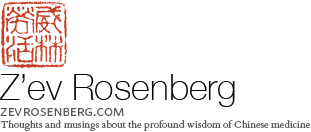Medical journal 7/12/15 on Summer Epidemic Qi
by Z’ev Rosenberg, L. Ac.
Update on summer epidemic qi pattern: A few weeks from my last report, this particular form of epidemic qi is still sticking around. About ten days ago, a heat wave with high humidity flowed up from Mexico on southerly winds, firing up a rare thunderstorm here in San Diego! This was immediately followed by yet another spring-like inversion of hot desert air over cool Pacific air, causing persistent low clouds and relatively cool temperatures. As mentioned earlier, a disease pattern developed with primarily gastrointestinal symptoms. I treated several patients with similar pulse images: R cun and guan pulses that were either replete or rough, along with L guan wiry/slippery pulses, which alongside the main symptoms, indicated a combination disease of shaoyang and yangming, in varying degrees. Some patients had hot, bright yellow diarrhea, that would sometimes improve, disappear, and then return. Others had dry constipation (a minority). One case had nausea and vomiting. At various stages and with various patients I utilized Ge gen huang qin huang lian tang, Da chai hu tang, and Huang qin tang with good results.
In some patients, this gastrointestinal pattern alternated or combined with the aforementioned respiratory pattern. This pattern began with scratchy throat and progressed to sore throat with difficulty swallowing, body aches, fatigue, loss of voice, alternating chill and heat effusion. At a later stage, some patients developed a severe barking cough, some dry, sometimes with thick, hard to expectorate green phlegm. One patient came to me at the stage she contracted pneumonia. Formulas that were useful at various stages included Ma xing shi gan tang, Ge gen tang, Chai hu gui zhi tang, and Chai hu gui zhi gan jiang tang.
Acupuncture strategies were based on affected channels, using distal points unilaterally on opposite sides (such as TB3 on the right hand, GB43 on L foot for shaoyang), focusing on affected channels, combined with abdominal, chest and associated back shu points. On a few patients, I used plum blossom and cupping on the upper back, and used fengfu/Du 16 and fengchi/GB 20 frequently.
A major difficulty in treating a few of these patients was that they were also being treated with antibiotics, steroid sprays or zinc/vitamin C, and in these cases Chinese medical treatments were either less effective, or the course of treatment was lengthened, as suppressive therapies weakened the body’s responses while dulling symptoms. Lacking in-patient facilities or the ability to see patients daily, sometimes these responses are understood, but it does show the reality under which we practice. Patients in traditional Asian cultures (before the modern era) were not so eclectic in their choices of treatment, and therefore results were stronger and easier to predict.
I also noticed that the severity of illness was directly proportional to the degree of exhaustion from overwork, lack of sleep, travel, poor diet and lifestyle, and emotional taxation, i.e. 勞損lao sun/taxation detriment. These are important factors to consider when using jing fang formulas in treatment. It’s not always the fault of formula efficacy or practitioner skill, but desensitization to natural forms of treatment by overuse of pharmaceuticals, supplements (often cold in nature, such as minerals and vitamin C), and issues with diet and lifestyle.

